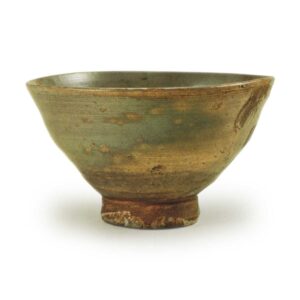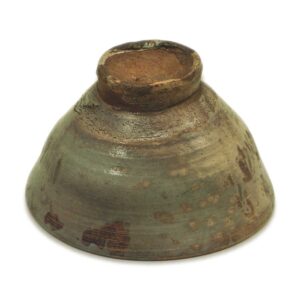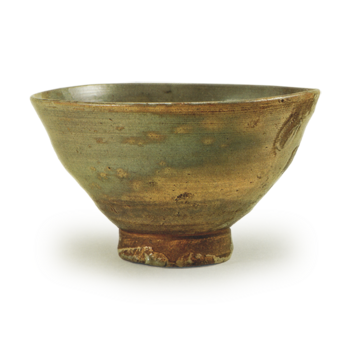

Height: 8.1-8.8cm
Diameter: 14.3-14.5cm
Outer diameter of foot ring: 5.8-6.2cm
Height of foot ring: 1.4-1.6cm
Among the so-called Koryo tea bowls, there are quite a few that do not fall into any clearly defined category, and among these there are not a few that are highly prized as famous bowls. This Enshu Koryo is one such famous bowl, and although we don’t know the exact origin of the bowl, whether it was owned by Kobori Enshu or not, it is thought that it was closely related to Enshu, as the calligraphy on the box is by Enshu’s pupil, Toyokobō Shinkai. According to a note by Nobukai, the name “Ikka” is taken from the Japanese poem “Isarara wa nohe no chigusa no hitohana ni saku tsukeru hana wo kasoe tsuzu mi”. The white specks on the light blue surface of the bowl are likened to the single flower of the thousand flowers in the field.
This teacup is tall and sturdy, with a rugged appearance that immediately catches the eye. The foot ring in particular is full of energy, and the foot ring, which has been carved out particularly high and wide, stands firmly with its base spread out, and the edge of the rim with tatami mat has a wide chamfer. If this were cut deeper, it would resemble a bamboo joint. The inside of the foot is hollowed out in a rounded shape, and the rough brown surface is left exposed. Also, the base of the foot is gouged deeply by the excess force of the chisel, and the foot is then scraped off around the base of the foot. As a result, the area from the waist to the hem appears to be even thinner. The area from the waist to the rim of the mouth naturally widens while showing a gentle inflection, and the rim of the mouth is slightly open, and the area around it is thin and vivid, with the marks of the potter’s wheel clearly visible.
The body is coarse and firmly fired, and in the mixture of light blue-grey and leaden grey, the dull cream-colored glaze is unevenly distributed over about one third of the side, and small glaze spots are scattered around it.
The glaze is roughly applied, and the marks of the artist’s fingers and the fire marks are left as they are.
The upper half of the vessel is thin, while the lower half is quite thick, and there are also some parts where the glaze has been wiped off in a very careless manner. In addition, the glaze has flaked off in large areas on the inside and outside of the foot ring, revealing the brownish-red clay body. Furthermore, the marks left by the tatami mat have darkened, and the remaining glaze layer has become kaaragi, creating a truly desolate landscape in this area, but it is also the most important highlight of this tea bowl.
The inside of the bowl is also deep and wide, with a clear line of the potter’s wheel marks running around the middle, and in the light grayish blue, the whitish Gohon pattern corresponding to the outside appears in patches, with the Hi-ma pattern also mixed in. There are also faint traces of sand-like marks around the tea-drip area, and a ring of dark spots in a snake-eye pattern. This is probably the result of “shitta” (a technique in which the surface of the tea bowl is scratched with a bamboo stick). The name “Ikka” is written on the bowl, and it is a tea bowl that should be called “O-tabi” (a type of tea bowl with a rough, unrefined atmosphere).
The origin of the tea bowl is unknown, but it was owned by Naraya Matsumura Soetsu, a tea master from Echigo Yuzaki who was also skilled in poetry and painting. Matsumura Soetsu studied the tea ceremony under Sen Gendo and was known as the best tea master in Hokuriku. He passed the tea bowl on to his student Hirokawa Hyakuo, who was a lumber merchant in Niigata and also a well-known haiku poet. The history of the tea bowl after that is unclear, but it is currently in the collection of a certain family in the Kansai region.
The bag that comes with it is from Enshu Tetsuyo, and the gold-powder calligraphy on the inside of the lid is by Shinkai Toyokubo, and it says “Enshu Korya Tea Bowl”. On the inside of the lid, there is also the signature “Shinkai (signature)”, which says “I will look at the flower that blooms in the field, comparing it to the flower that blooms in the field. Hozobō Shinkai, also known by the names Takao and Gōan, was a student of Isshō Kado. He was a master of kyōka (comic tanka) and a high-ranking disciple of the Enshū school of tea ceremony. He died in 1688 at the age of 54.



